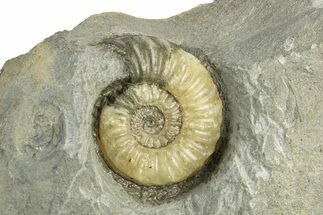This Specimen has been sold.
3" Ammonite (Promicroceras) Cluster - Marston Magna, England
This is a 3" wide stone containing many small ammonite fossils. The ammonites are of the species Promicroceras marstonense and are Lower Jurassic (~200 million years old) in age. This rock is quarried near Marston Magna, Somerset, England. Locally this ammonite filled rock is known as "Marston Marble".
The site that produces this material is no longer accessible. Because of this, these specimens are becoming increasingly harder to obtain. The piece has been painstakingly prepared with mechanical tools to expose all of the individual ammonite fossils.
The site that produces this material is no longer accessible. Because of this, these specimens are becoming increasingly harder to obtain. The piece has been painstakingly prepared with mechanical tools to expose all of the individual ammonite fossils.
About Ammonites
Ammonites were ancient marine cephalopods, similar to today's squids and octopuses, but with a defining feature: their distinctive, tightly coiled spiral shells. These shells, resembling those of modern nautiluses, served as both a protective home and a buoyancy aid, allowing ammonites to navigate the prehistoric seas with ease. First emerging around 240 million years ago in the Triassic Period, ammonites thrived for over 175 million years, adapting through numerous forms and sizes. As predatory creatures, they likely fed on smaller marine organisms, using their tentacles to capture prey. However, their long reign came to an end 65 million years ago at the close of the Cretaceous, coinciding with the mass extinction event that also eliminated the dinosaurs.
Ammonites were ancient marine cephalopods, similar to today's squids and octopuses, but with a defining feature: their distinctive, tightly coiled spiral shells. These shells, resembling those of modern nautiluses, served as both a protective home and a buoyancy aid, allowing ammonites to navigate the prehistoric seas with ease. First emerging around 240 million years ago in the Triassic Period, ammonites thrived for over 175 million years, adapting through numerous forms and sizes. As predatory creatures, they likely fed on smaller marine organisms, using their tentacles to capture prey. However, their long reign came to an end 65 million years ago at the close of the Cretaceous, coinciding with the mass extinction event that also eliminated the dinosaurs.
SPECIES
Promicroceras marstonense
LOCATION
Marston Magna, Somerset, England
FORMATION
Obtusum Zone
SIZE
Rock: 3 x 2"
CATEGORY
SUB CATEGORY
ITEM
#282017
We guarantee the authenticity of all of our specimens.
 Reviews
Reviews











